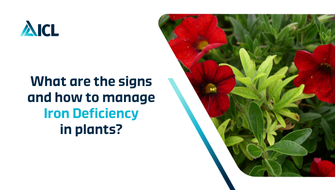Iron (Fe) deficiency, also known as ‘iron chlorosis’, is a common problem that affects many plants – particularly those preferring acidic soil conditions – ericaceous species such as rhododendrons, azaleas, camellias, hydrangeas (blue flowers) and gardenias. It also affects many common bedding plants, such as Petunias, Calibrachoa and Antirrhinum as well as Vinca.
Iron deficiency can indicate root health problems and the presence of a pathogenic root fungi, such as Pythium.
An essential plant micronutrient, Iron deficiency can lead to a range of symptoms and negative impacts on plant health.
What are the symptoms of Iron Deficiency?
- Yellowing of young leaves: the most common and noticeable symptoms, while veins remain green – interveinal chlorosis.
- Reduced growth: stunted growth, as the plant struggles to produce sufficient chlorophyll – essential for photosynthesis.
- Leaf drop: in severe cases, affected leaves may drop prematurely.
- Poor flower (and fruit) development: reducing overall aesthetic appeal.
Iron is a key component of chlorophyll, the pigment responsible for capturing sunlight and converting it into energy through photosynthesis. A deficiency therefore reduces a plant’s ability to produce energy and grow. It also weakens immunity, making it less able to defend itself against diseases and pests. Chronic iron deficiency makes plants more susceptible to environmental stresses, such as drought or extreme temperatures.

Iron Deficiency in Cham. Laws. Columnaris.
How should you manage Iron Deficiency?
Monitor regularly for signs of iron deficiency, as early detection and treatment are key to preventing severe damage. Growing media pH is a key factor. For long-term crops, monitor the growing media pH. If too high, consider lowering by adding amendments like elemental sulfur or acidifying fertilisers to make iron more available to plants.
Peat-free media tend to have higher pH’s, making Iron less available to plants roots. ICL recommends incorporating Micromax Premium, a slow release trace element fertiliser, into the growing media mix to prevent problems.
How should you prevent Iron Deficiency?
Micromax Premium – This high-performance granular fertiliser provides all essential trace elements, including iron, in a single application. Designed for maximum efficiency, it:
- Supports healthy plant growth for up to 16 months.
- Works effectively even in growing media with a pH above 6.5.
- Is easy and safe to use.
Micromax Premium is a key ingredient in our Levington Advance bagged range and Levington Advance bespoke mixes.
How to correct Iron Deficiency?
Peters Foliar Feed – Foliar feeding provides a quick solution, particularly in conditions where the root zone is wet. While a specific iron product (such as Micromax WS Iron) can be used, plants often lack many nutrients and a total nutrient product, such as Peters Foliar Feed (27+15+12+TE) provides a fast solution.
Micromax WS Iron – A premium, fully water-soluble fertiliser, Micromax WS Iron consists of 6% EDDHA-chelated iron, plus X3 – a biostimulant that enhances absorption of Fe-chelate compound into plant leaves – optimising nutrient uptake:
- Iron deficiency disappears within a few days.
- Easy to apply, Micromax WS Iron dissolves quickly and completely.
- Can be tank mixed with a wide range of other fertilisers and crop-protection products.

Iron Deficiency in Calibrachoa
Did you know?
Waterlogged soil, or heavy irrigation cycles, can reduce iron uptake by the roots due to loss of root hairs, so ensure plants receive adequate, but not excessive, water.
Iron deficiency can be a persistent issue in field-grown horticultural crops, especially in regions with alkaline soils. Proper soil management and nutrient supplementation are crucial for maintaining healthy and vibrant plants.
0 Brands found
0 Products found
13 Resources found














